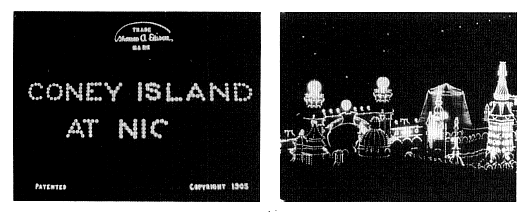Actualities and Short Subjects
Although the production of narrative features had increased dramatically by early 1905, Edison cameramen continued to generate a diverse selection of films. Porter photographed news and sporting events like President Roosevelt's Inauguration (with Robert K. Bonine); Play Ball-Opening Day, NYC (April 1905), which showed the baseball game between John McGraw's New York Giants and the Boston Braves;[53]Opening of Belmont Park Race Course (May 1905); and Start of Ocean Race for Kaiser's Cup (May 1905). Spectacular Scenes—N.Y. City Fire (December 1905) showed "the destruction of the Lackawanna and Jersey Central Railroad Ferry Houses."[54]Scenes and Incidents, Russo-Japanese Peace Conference was photographed on August 8, 1905, in Portsmouth, New Hampshire—the setting for President Roosevelt's mediated settlement of the Russo-Japanese War. It offers an interesting case study in the production of newsworthy actuality subjects in 1905.
Scenes and Incidents, Russo-Japanese Peace Conference, Portsmouth, N.H . sold thirty-one copies, or 24,800 feet of film—almost 40 percent of Edison's actuality footage for 1905. It also provoked a court case. The story begins in mid July, when George H. Keyes of the Portsmouth Observation Company arranged for an Edison photographer to come to Portsmouth, New Hampshire. Porter arrived a week later and took a 220-foot subject of a dynamite explosion that widened the Piscataqua River. Total cost to Keyes:
220 feet negative @ 40¢ per foot | $88.00 |
220 feet positive @ 12¢ per foot | 26.40 |
Porter's expenses | 25.90 |
$140.30[55] |
The negative was held at the Edison lab and prints sold to Keyes. Keyes was eager to have Porter return the following week and film the ceremonies surrounding the Russian-Japanese Peace Conference. He thus brought the most popular news subject of 1905 to the Kinetograph Department's attention.
Once Edison executives were informed of the event, they decided that the subject should be marketed commercially rather than made for a commission. Moreover, the Kinetograph Department wanted an exclusive and so appeared to cooperate with Keyes without actually committing itself to his request. When
Porter complemented the fantasy world of lights that was Coney Island at night with animated titles.
Porter returned to Portsmouth on August 6th, Keyes learned that the cameraman would not be in his employ. Duped, Keyes angrily contacted the Biograph Company, which agreed to supply a motion picture photographer, who arrived the following day. Fortunately for Keyes and Biograph, but unfortunately for Porter, the ceremonies that had been scheduled for August 7th were delayed until August 8th.[56] Keyes now tried to turn the tables by initiating a suit against Edison, so that Porter's camera equipment was attached an hour before the festivities. Fast work enabled Porter to reach a bondsman, free his equipment, and still photograph the pageantry. Without Keyes, neither Edison nor Biograph would have filmed this historic event.
During 1905 the Kinetograph Department also produced a few human interest films like Steamboat Travel on the Long Island Sound (August 1905) and Firemen's Parade, Scranton, Pa . (September 1905).[57] Neither was considered important enough to copyright. Coney Island had been a favorite locale for this type of subject, and the Edison Manufacturing Company acquired "the exclusive privilege for the season of 1905 at Dreamland, one of the principal parks."[58] For Coney Island at Night (June 1905), Porter's camera caressed the lit-up amusement center with long sweeping pans, producing an eerie beauty. Other subjects made under this arrangement included Hippodrome Races, Dreamland, Coney Island (June 1905), Mystic Shriners' Day, Dreamland, Coney Island (July 1905), and June's Birthday Party (July 1905), as well as Boarding School Girls .
In June an Edison photographer took several short films in Bliss, Oklahoma, with Lucille Mulhall's Wild West Show. Such films as Lucille Mulhall Roping and Tying Steer, Great Buffalo Chase , and Western Bad Man Shooting Up Saloon sold between one and six prints.[59] Short comedies from 1905 included Unfortunate Policeman and Digesting a Joke . In the latter film comedian James T. Powers cuts out an amusing article from a paper, swallows it, and seems to
find its contents amusing as he digests it.[60] (None of these subjects were copyrighted, although descriptions can be found in Edison's July 1906 film catalog.) The Edison Company was able to offer many more short comedies by selling individual scenes from its longer films. In 1905-6, the company sold nine copies of "Burglar and Bulldog" from The Burglar's Slide for Life , eight copies of "Sneezing" from The Whole Dam Family and the Dam Dog , seven of "Girls and the Bumpety Bumps" from Boarding School Girls , and five of "Old Sweethearts" from The Seven Ages . This did not mean that Porter conceived of each scene as an independent film. The Kinetograph Department's sale of these separate scenes recognized that some exhibitors still wanted to purchase short subjects, even though such films could no longer be profitably produced for that purpose alone.
Miscellaneous subjects showed the sharpest decline in popularity and production. Among the handful to be photographed were Blowing Bottles and The Kilties Band : neither sold a single print. Sales figures and copyright practices make it clear that by 1905-6 all forms of motion picture production other than "feature"-length narrative films had become marginally profitable at best. The shift to longer story films was not a "choice" made by producers: it was a necessity determined by the tastes and demands of exhibitors and their audiences. Edison's variety approach to film production was in its final stages of decline as the nickelodeon era arrived; the rise of storefront theaters simply completed its demise.
